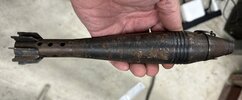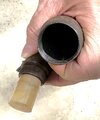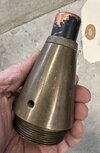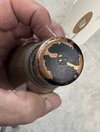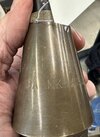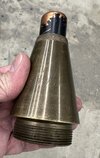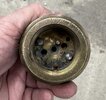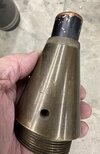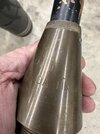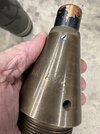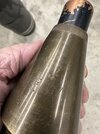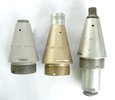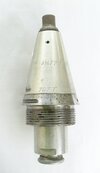At 39.5mm diameter I first thought that this was just possibly a larger variant of a French Losfeld subcaliber. Unscrewing the fuze however makes me think that this is a fully functiong item. Anyone recognize it? The fuze looks UK, but not the markings.
British Ordnance Collectors Network
You are using an out of date browser. It may not display this or other websites correctly.
You should upgrade or use an alternative browser.
You should upgrade or use an alternative browser.
ID Project 11
- Thread starter US-Subs
- Start date
2274/5/6. Whilst on first appearance it appears to be a No. 117 or direct descendant. However, the threaded portion appears too short (might be angle of photo) to be a detonating fuze. If it is an igniferous fuze, it's most likely to be a No. 230.
As Minenaz16 states "AN" in the right context would be Australian Navy, however the markings here don't follow accepted practice. No. xxx Mk xx N (if Naval). With the exception of Bofors fuzes I don't recall ever seeing any Australian Navy fuzes, if Ron or Graeme have any in their collection I would be interested to know if the Mark Number is suffixed with just an "N" or "AN"
@US-Subs - could we have a photo of the base and also, of all the markings?
TimG
As Minenaz16 states "AN" in the right context would be Australian Navy, however the markings here don't follow accepted practice. No. xxx Mk xx N (if Naval). With the exception of Bofors fuzes I don't recall ever seeing any Australian Navy fuzes, if Ron or Graeme have any in their collection I would be interested to know if the Mark Number is suffixed with just an "N" or "AN"
@US-Subs - could we have a photo of the base and also, of all the markings?
TimG
Thanks.
It would appear to have been manufactured by "MF" Footscray, Melbourne. The length of the threaded section is indicative of an igniferous 'British' fuze, such as a No. 230. I would think this is a 230 or an Australian variant. To the best of my knowledge the 230 was only for naval service, this would confirm Minenaz16 comment of "AN" being Australian Navy. I assume by 1974 Australia was breaking away from the regulations set by Woolwich, hence the format of the markings. @pedro might be able to shed more light on the matter.
TimG
p.s. The 230/230P were apparently obsolete in British service by 1959. They were used on the larger calibre naval guns. If this is a 230 replacement, presumably the Australian Navy still had some large warships in its fleet in the 1970s.
It would appear to have been manufactured by "MF" Footscray, Melbourne. The length of the threaded section is indicative of an igniferous 'British' fuze, such as a No. 230. I would think this is a 230 or an Australian variant. To the best of my knowledge the 230 was only for naval service, this would confirm Minenaz16 comment of "AN" being Australian Navy. I assume by 1974 Australia was breaking away from the regulations set by Woolwich, hence the format of the markings. @pedro might be able to shed more light on the matter.
TimG
p.s. The 230/230P were apparently obsolete in British service by 1959. They were used on the larger calibre naval guns. If this is a 230 replacement, presumably the Australian Navy still had some large warships in its fleet in the 1970s.
Last edited:
Having done some more research it transpires that nothwithstanding the 230 had a short intrusion, the same as a igniferous fuze in was in fact a detonating fuze but had to be used over a gaine! The only reference I can find to an Australian AN2 fuze, which was a proximity fuze is here https://navalinstitute.com.au/wp-content/uploads/2014/04/headmark-033-9-3-Aug-1983.pdf (page 39 onwards) interesting article on the Australian Proof and Experimental Establishment at Port Wakefied.
TimG
TimG
Hi TimG and US-Subs
Yes it is Australian as already stated. I find our Navy fuzes are very hard to find. Most Navy fuzes I find are just PRF in steel.
I have a similar brass fuze stamped: DA MK AN/2 MF 4/75 LOT 8.
Later fuzes are stamped : DA MK AN/2 MOD2 and are aluminium.
These are either plain aluminium or annodized in gold or gray finish. A lot of these do not have maker stamps and all seem to have come from MO factory when they closed down.
Few have the caps or gaines.
I show a group of the aluminium finishes.
I also show one in FUZE ADAPTER MK AN. MF 83 to fit 2" x14 thread fuzes in the larger 2.375" x 10 tpi projectiles like the 5" 54 cal.
Yes it is Australian as already stated. I find our Navy fuzes are very hard to find. Most Navy fuzes I find are just PRF in steel.
I have a similar brass fuze stamped: DA MK AN/2 MF 4/75 LOT 8.
Later fuzes are stamped : DA MK AN/2 MOD2 and are aluminium.
These are either plain aluminium or annodized in gold or gray finish. A lot of these do not have maker stamps and all seem to have come from MO factory when they closed down.
Few have the caps or gaines.
I show a group of the aluminium finishes.
I also show one in FUZE ADAPTER MK AN. MF 83 to fit 2" x14 thread fuzes in the larger 2.375" x 10 tpi projectiles like the 5" 54 cal.

